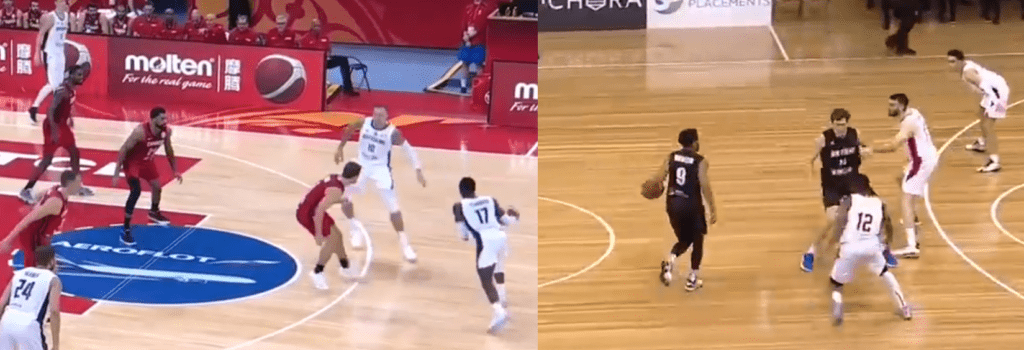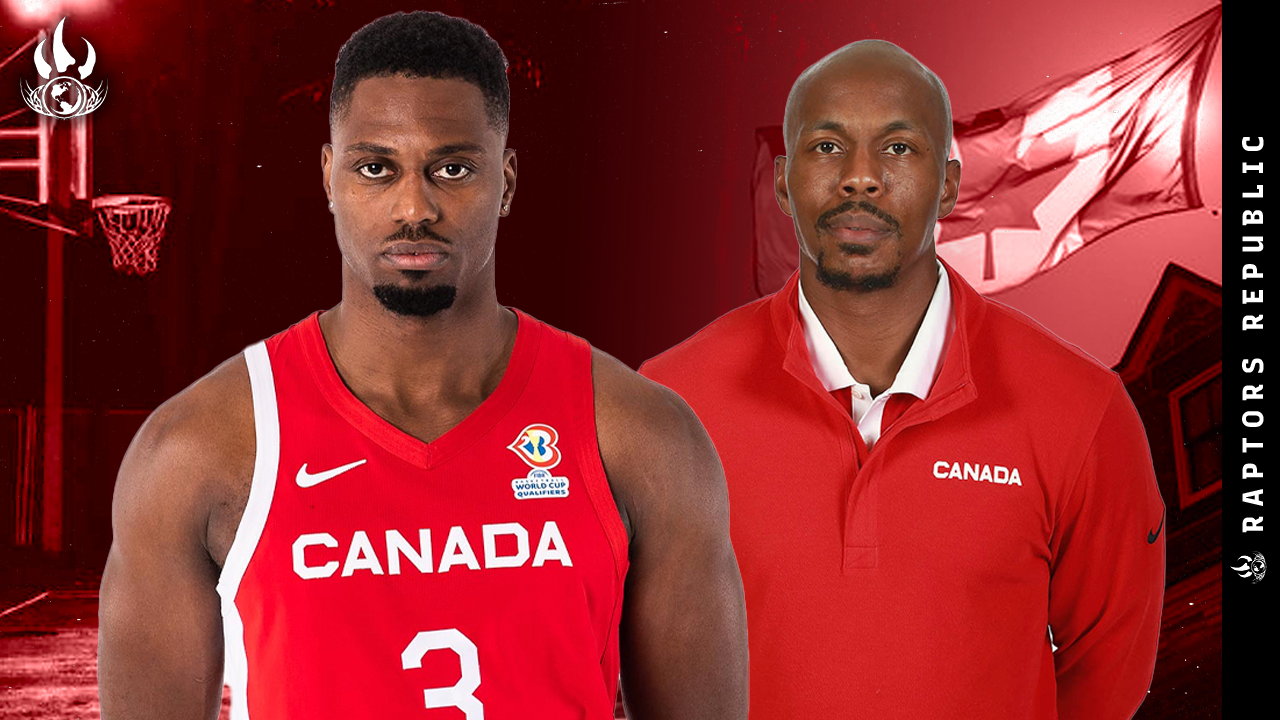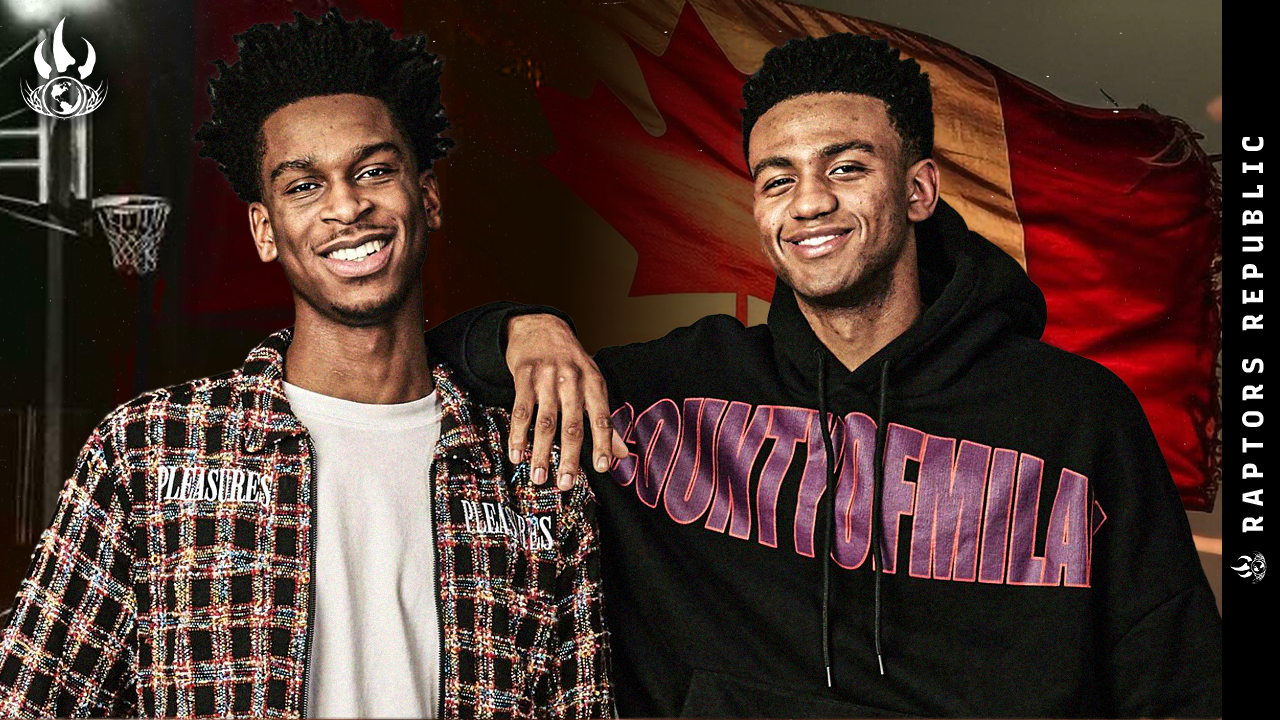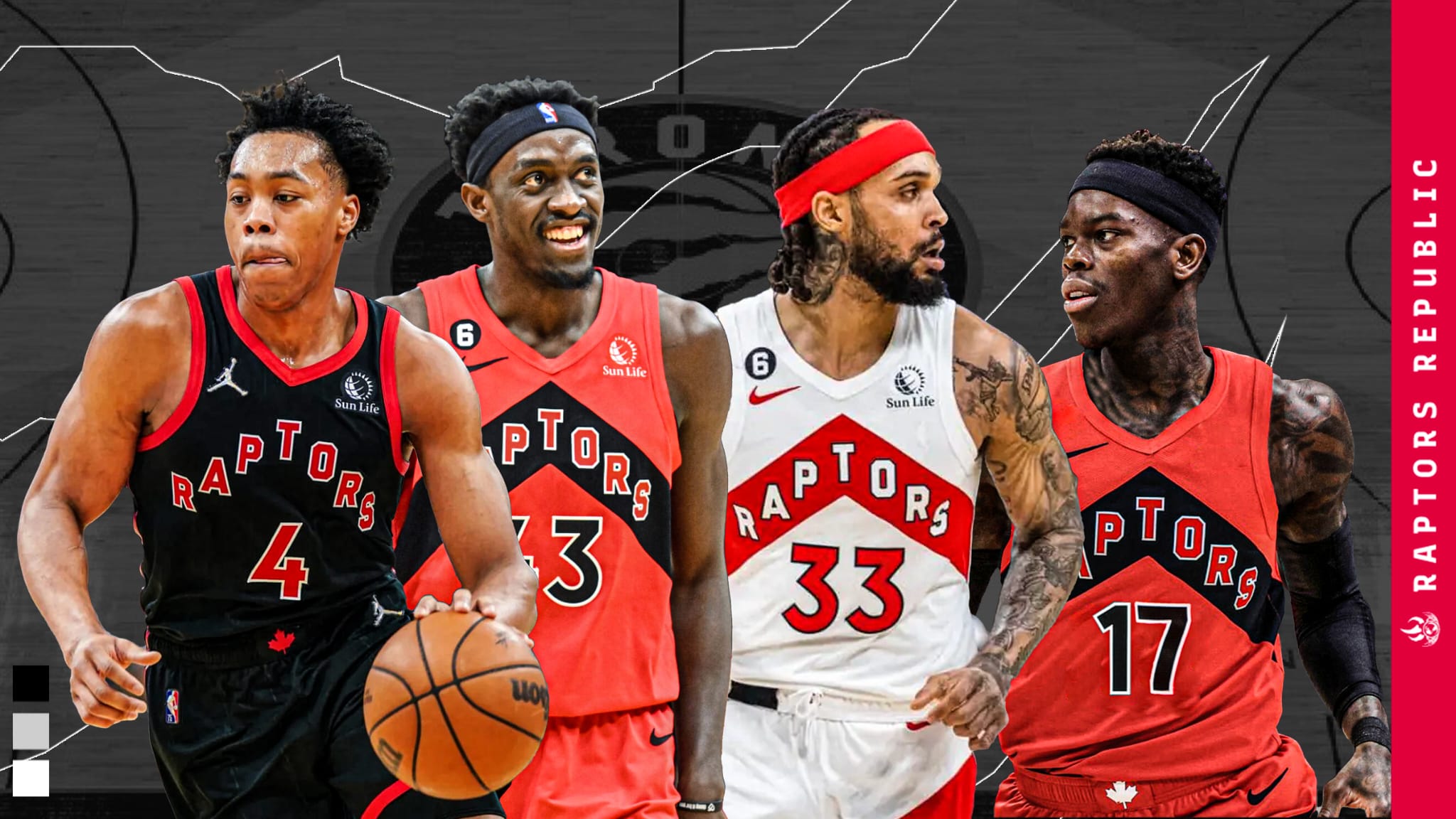After winning the DBB Supercup in Germany, Canada landed in Granada, Spain on Monday morning in preparation for their final two exhibition games (Aug 17th vs Spain, Aug 18th vs Dominican Republic). With the 2023 FIBA World Cup inches closer and closer, today we’ll take a deep dive into some defensive schemes.
Much like the Offensive Playbook (Part 1) breakdown, this deep dive will focus on Canada’s defensive schemes during the 2019 World Cup campaign (Part 2 of course will be 2021 and beyond). Despite the roster turnover and head coaching change since the previous World Cup, there’s some good (and bad) principles and ideas that I think can help inform Jordi Fernandez’s defense at the 2023 World Cup. Fernandez did have high expectations for Canada’s defense saying, “We’d be selling ourselves short if we’re not the best defense in the tournament and (by proxy) the best defense in the world” at training camp. Through 3 exhibition games, I don’t think Canada will be anywhere close to the best defense in the tournament, but much can change over the next couple of weeks.
Before we dive into the film, lets first look at some numbers between the 2019 World Cup and Nick Nurse’s 2022-2023 Raptors. There isn’t any publicly available deflection stats for the 2019 World Cup, which is unfortunate so I stuck with the traditional steals and blocks, which don’t always tell the full picture.
| Steals (per game) | Steals (per minute) | Blocks (per game) | Blocks (per minute) | |
| 2019 WC SMNT | 8.6 (5th in tournament) | 0.215 | 2.4 (tied 20th in tournament) | 0.06 |
| 2022-2023 Toronto Raptors | 9.4 (1st in league) | 0.195 | 5.2 (9th in league) | 0.11 |
Pick and Roll (Ball Screen) Coverages
The pick and roll (PnR) is a staple of modern offenses at all levels in basketball, and it’s easy to see why. The screen that is set opens up a momentary advantage for the ball handler to attack a tilted defense. For the most dynamic of guards, these momentary advantages are all that’s needed to punish opposing teams again and again throughout the game. Designing a defensive scheme that is effective for your team’s personnel and against your opponents personnel is vital to the success of any team.
With Canada’s roster for the 2019 World Cup, Nick Nurse made the right decision to play more conservative defensive PnR coverages compared to what his Toronto Raptors employed. The frontcourt for Canada lacked the foot speed and agility to play the “switch-everything” defense the Raptors have employed for the last couple of years. So what did Nurse’s defense look like?
The base coverage for Canada in PnR’s was to have the big (referred to as “xscreener”) drop and the ballhandler’s defender (referred to as “xballhandler”) fight over the screen and recover. The clip below is how the SMNT would typically defend a PnR. Kelly Olynyk in deep drop with Kevin Pangos fighting over the top of the screen to try and recover.
This sequence from the final World Cup game once again shows Canada’s default coverage. Owen Klassen plays in deep drop while Nembhard fights over the screen. This time I want you to pay extra attention to Melvin Ejim (#3 red), who comes over and “tags” the rolling Theis on the weakside while Klassen is occupied trying to contain Schröder. Defenses at the professional level are so nuanced that this small action of “tagging” the roller might go unnoticed, but it’s incredibly important to PnR defense. If Ejim, doesn’t “tag”, this is an easy pocket pass from Schröder to Theis, who all of a sudden has an open roll to the basket. This tag concedes the skip pass to the corner, which in theory is the harder pass to execute and because the ball has to travel a further distance, it gives Canada’s defenders more time to recover.
However, when a team runs an empty PnR (the roller rolls on an empty side of the floor), there isn’t any defender to tag the roller. As a result, the dropping big defender (“xscreener”) has an even tougher job playing both the ball handler and roller. If they commit too much to the ball handler, the roller will be wide open since there is no tag. And if they commit too much to the roller, then the ball handler has an easy lane to the basket.
Canada’s response to empty PnR’s was to once again involve a third defender, not as a tagger, but this time to stunt and help from the nail. This extra defender (Phil Scrubb in the clip below) helps to momentarily contain the ball handler, giving the “xballhandler” (Aaron Best) more time to recover and lets the “xscreener” (Owen Klassen) focus on guarding the rolling big. Notice how t here was no Canadian defender in the far corner to tag the roller here.
Even within “drop” coverage, the scheme would change slightly depending on who was the “xscreener” on the play. Owen Klassen preferred to play more “at the level” of the screen, before dropping or crowding the ball handler.
Meanwhile Khem Birch played the more traditional deep drop coverage, usually sitting the paint (remember there’s no 3 second rule in FIBA). The side-by-side comparison between the two and this subtle difference in coverage becomes much more obvious.

This summer, I think Olynyk, Powell and Alexander will all play a combination of at the level and deep drop, while Zach Edey will exclusively be a deep drop big. Through the first couple of exhibition games, I do have some concerns with Canada’s bigs in PnR defense. Aside from Kyle Alexander, the rest of Canada’s bigs all have major defensive flaws that can be exploited in the PnR. Canada’s best shot at becoming decent at defending the PnR is relying on their strong POA defense. Dillon Brooks and Lu Dort especially relatively good at screen navigation, and the hope is NAW, SGA and Barrett’s length can also play a factor.
If the ballhandler is a weak outside shooter (though Schröder got hot against Canada on Sunday) , Canada would sit in their base drop coverage and have the “xballhander” go under the screen, and happily concede an outside shot.
Playing “drop” coverage is not a perfect defensive scheme by any means. Canada was especially vulnerable to pick and pop action. On this sequence here, Olynyk does his job to drop and stay with the ball handler until Pangos fully recovers, which unfortunately never happens and as a result Olynyk is fully occupied contesting the drive. Aminu (#7 for Nigeria) is wide open for 3, and if the pass had hit him, I’m not sure Joseph could rotate over in time to really contest the shot. Even if Joseph did “X-Out”, no Canadian defender was in position to rotate to the corner.
It would not be a Nick Nurse defensive scheme without any switching. What I liked about the 2019 campaign was how selective Canada was when they decided to switch. I’ve compiled 4 clips in the video below, but the main takeaway is Canada was comfortable with what I’ll call “like switching”. Switching handoffs/ball screens when similarish sized players were involved (think guard-guard, guard-wing, big-big, etc.).
- In the first clip, Scrubb and Joseph switch the initial handoff and Scrubb also “ices” the ball screen to prevent middle penetration. Possession doesn’t really go anywhere for Nigeria
- Canada once again switches the guard-guard handoffs before Joseph does a “veerback switch” or “late switch” with Brissett.
- Canada anticipates USA trying to target Wiltjer in PnR and pre-switches Aaron Best onto Harrison Barnes. Then it’s a “like switch” between the Best and Kajami-Keane (guard-guard).
- “Like switch” again this time between Ejim and Brissett (wing-wing). Birch also switches at the last second in order to contest the 3 after Pangos is hung up on the flare screen.
I expect this type of selective switching to carry over this summer under Jordi Fernandez.
Besides playing drop and switching, Canada would very rarely bring two to the ball handler to blitz. This was very situational though with the location of the ball screen having a large impact on when Canada blitzed. This clip below was the perfect opportunity to blitz the ball screen, with the sideline acting as a third defender trapping the ball handler. With Olynyk (or really any Canadian big other than Edey), these blitzes feels like a surprise defensive coverage Canada can use as a curveball every now and then to give opposing ball handlers different looks. In Sunday’s game against Germany, Canada did try to have Olynyk blitz a couple ball screens after he was being targeted in drop. It was only a couple possessions, so it’s hard to say how much more effective it was.
Ball screen location wasn’t the only factor that could get Canada blitzing. Strong pull-up shooters like Patty Mills (who has shot 40.3% on pullup 3’s in his NBA career) that would eviscerate drop coverage was another factor. On this sequence, Phil Scrubb and Kyle Wiltjer blitz the ball screen in order to get the ball out of Mills’s hands and force Jock Landale to create.
And here’s an even more scarcely used coverage from Canada. “Strong”, or forcing the ball handler to his right was used (or attempted is probably more accurate here) by Canada almost exclusively when defending Joe Ingles in the PnR. You can see Pangos flip his hips here and concede the screen and the middle of the floor to Ingles in an effort to deter a drive to Ingles’s dominant left hand. It doesn’t end up working because Ingles, showing his craft, “snakes” the PnR, occupying the dropping Klassen and Pangos
I have to stress that defensive coverages are extremely personnel and matchup dependent. With Canada with an almost new roster and playing a whole new set of opponents at this summer’s World Cup, the specific game-to-game adjustments made by Jordi Fernandez can, and probably will, differ from what we’ve seen thus far in this preview. From the Supercup Finals against Germany, Fernandez already implemented a couple in-game adjustments that I caught, so here’s hoping this type of problem solving continues from Canada’s coaching staff when the real competition starts.
Off-Ball Schemes
The first thing we’ll look at is how Canada defended wide pindowns/stagger screens for opposing shooters. Defending these actions require a significant amount of focus, communication and awareness from all 5 players on the court. One minor mistake can snowball into a full defensive breakdown very quickly.
Nurse’s philosophy has always been to aggressively deny the pass to elite offensive players and dangerous shooters (think of why he runs box-and-1 for instance) and that was no different for the SMNT. In general, Canada would “lock and trail”, conceding the usage of the screen, but having the defender stay on the shooter’s hip and fight through screens in an effort to deny the pass.
Why would Canada ever want to concede the usage of the screen? It sounds counterintuitive to just give something up so easily. Well, offensive players have an array of ways to use an off-ball screen (think rejecting, curling, flattening the angle, etc.) and these different options makes it incredibly difficult to defend. Canada’s approach was to cut down on these options, essentially forcing the offensive player to always use the screen. Simplifying their defensive coverage and making it easier on Canada’s players as they only need to anticipate 1 possibility.
Consider this sequence here from Canada’s first exhibition game for the 2019 World Cup. Nigeria is set up in “Floppy” action, with stagger screens and a pindown on either side for Jordan Nwora to use. Melvin Ejim is face guarding him, and once Nwora elects to use the staggered screens, Ejim fights to remain on Nwora’s hip and blows up the last screen to deny the pass entirely (in other words Ejim “locks and trails“). Forces Nigeria to move to their secondary action and the offensive possession goes nowhere.
When the pass was made to the shooter and the “lock and trailing” defender was out of position to recover, Canada would “next” the off-ball screen by having the closest (or “next”) defender switch. Here’s an example of what this coverage looks like. Phil Scrubb, is in “lock and trail” position, allowing Chris Goulding (#4 Australia) to come off the stagger screens. Unfortunately, Scrubb doesn’t do a great job of staying attached on this possession, and by the time Goulding catches the ball, he’s still hung up on the final screen and way out of position. As a result, Pangos, “nexts” the screen and slides over to cover Goulding, with Scrubb going to guard his man.
Here’s one more example of Canada “nexting” the off-ball screens to contest shooters, this time between Aaron Best (#12 red) and Duane Notice (#2 red).
The next section we’ll look at is how Canada defended postups. When opposing teams hunted mismatches in the post off of Canada switching PnR’s, Canada would fall back on “scram switching“, essentially bumping out the smaller guard with a switch with a big. As an aside, this defensive tactic is quite common in the switch heavy defensive schemes in the NBA. The following clip is a textbook example of the “scram switch”. Kaza Kajami-Keane (#10 Canada) is switched onto the rolling Landale who sets up at the elbow. Rather than give up the mismatch, Canada brings Owen Klassen from the weakside to switch onto Landale while the pass is in the air, negating the mismatch.
If the ball got into the post in an advantageous matchup for the opponents, Nurse was not afraid to bring extra defenders to the ball. On this defensive possession, Cory Joseph has nobody to scram switch with him and so Canada brings help from the top. Former Toronto Raptor Fred VanVleet was exceptional at making these reads and timing his double teams.
Here’s another example of Canada doubling the post from the one pass away as Joseph is caught again in a mismatch.
Even when Canada’s bigs were defending the post, they would bring EXTRA defenders to the ball, especially against strong postup tacticians. This aggressive doubling scheme would often leave Canada’s weakside defenders in tough positions, having to recover over long distances to contest. Just look at how far Nembhard has to cover to closeout to the corner.
One interesting thing that Nurse liked to do was have his bigs smother opposing bigs (even if they were non-shooters) on the perimeter. You can see the intentional pressure from Birch when Aron Baynes catches the ball at the top, perhaps in an attempt to crowd and rush him into a bad decision.
Zone Defense
The amount of times Canada went to some type of zone defense to mix things up in 2019 is the most obvious clue that they were coached by Nick Nurse. 2-3 zone, 3-2 zone, it was all on the table for Canada, who tried to disrupt the flow and catch teams off guard, especially when coming out of timeouts. Current SMNT assistant coach Nathaniel Mitchell also did this quite often when he was the head coach at 2023 GLOBL JAM, so it’s likely we see Canada try this out at the 2023 World Cup.
And of course, I haven’t even touched on Nick Nurse’s “m.o”, the box-and-1 and triangle-and-2, which there was plenty of!
I doubt Jordi Fernandez will play a box-and-1, but I am sure he will go into a zone defense in certain situations. In fact, he’s already done it before, playing a 2-3 zone with Zach Edey on the floor against Germany in the Supercup Finals.



